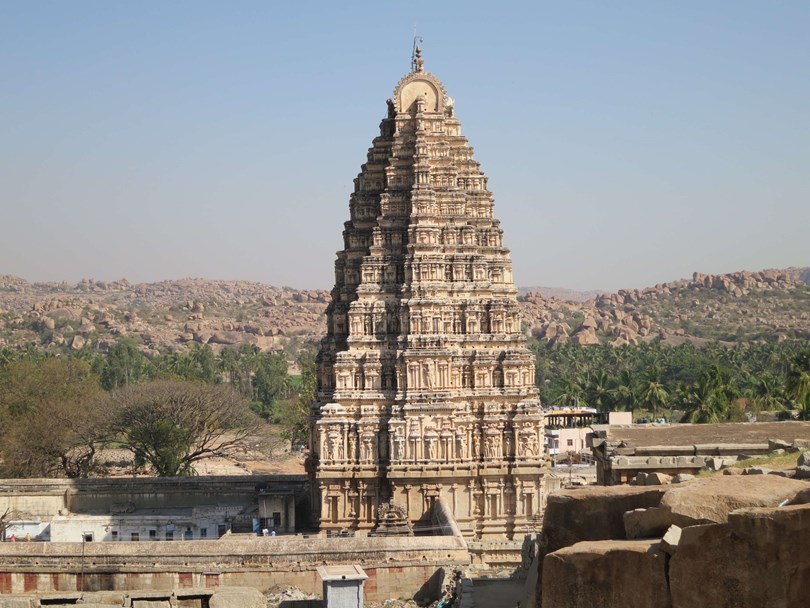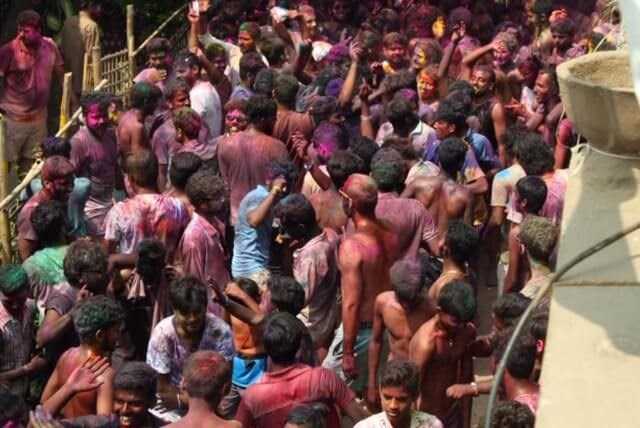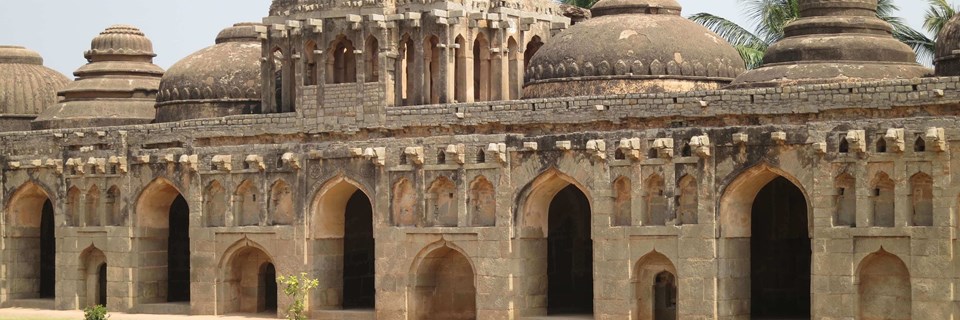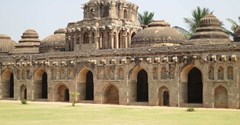Hampi is one of India's most fascinating ancient sites. Discover our recommended best places so see on your visit.
 Introduction to Hampi
Introduction to Hampi
Located in Karnataka, Southern India, with a population of around 3000 people, it would be easy to overlook Hampi as a small, unimportant village. Yet, its rich cultural and religious history spanning over a millennium places it amongst the most significant sites for any traveller exploring India - with over 1600 ruins and a UNESCO certification to boot. Travellers should plan to coincide their visit with the many festivals which are fervidly celebrated in Hampi.
- Vijaya Vittala Temple
Undoubtedly one of the most important sites to see when visiting Hampi is the Vijaya Vittala Temple. This renowned Hindu temple, among the oldest and best preserved of its kind in the entire world, was built around the 15th century by the king of the Vijayanagara Empire in dedication to Lord Vitthala, an incarnation of Lord Vishnu. The architectural brilliance of the Vijayanagara Empire can be seen all across the sprawling expanse of the temple complex yet it is best exemplified in the two most famous attractions of the temple: the Stone Chariot and the Musical Pillars of Ranga Mantapa. The world renowned chariot, in its beautiful ornate detail, truly displays the incredible craftsmanship of this forgotten empire and it is no wonder why it is called the ‘Jewel of Hampi’. Moreover the pillars, whilst not only providing structural support for a lavish and elaborate waiting hall for the rulers of the empire, play a unique musical note when hit. Indeed, as it truly fascinated the British settlers in the 19th century, the temple is sure to spark curiosity in any visitor today.
2. Sri Virupaksha Temple
Another of the most fascinating sites in Hampi is the Sri Virupaksha Temple. Perhaps the most memorable of Hampi’s temples, the Virupaksha temple - dedicated to Lord Shiva - is the main centre of pilgrimage in Hampi and is still used in worship to this day. Just a short walk from the old town, the first archaeological evidence of shrines built on the current site date back as far as the 7th century and it is here where travellers can see the oldest of all the shrines in Hampi. Given the importance of Hanuman, the Hindu monkey God, in Hampi visitors can explore the temples grounds accompanied by fearless monkeys.
3. Hemakuta Hill Temple Complex
Just a short walk or cycle from the Virupaksha Temple is the Hemakuta Hill Temple Complex. Here, all within a small radius, one can discover more about the Vijayanagara Empire and their culture. There are two shrines dedicated to Ganesh - the Hindu elephant God. One big and one small. Whilst just a short walk away is the Krishna temple where more magnificent stonework can be observed. Whilst sitting directly opposite is the remains of the ancient Hampi bazaar where the Empire, which at one point was one of the richest in the entire world, traded with the rest of the world. Just half an hour walking around the complex and you can gain a richer understanding of the lives of the Vijayanagara people. Certainly the entire village is a photo opportunity as the hill presents the best view for sunrise and sunset. The legend of the town states that Lord Siva, upon marrying Pampa - a local girl from the village - rained gold on the hill. Thus it is from the summit one can truly appreciate the stunning local landscape illuminated by the golden Indian sun.
4. Lakshmi Narasimha Temple
A small walk from the hill temple complex, one can find the Lakshmi Narasimha Temple. Here, visitors can observe a monolithic statue of Narasimha - the half-man, half-lion incarnation of Lord Vishnu - and Goddess Lakshmi (his consort). Though damaged in the Mughal raid that ended the Vijayanagara Empire in the 16th century, it is still the largest statue to be found in Hampi and is well worth visiting. The duality present in the image of Narasimha and Lakshmi is incredibly striking as it displays the powerful depths of destruction and creativity that exist in the world.
5. Queen’s Bath and Palace
A couple miles from the main village lies the Queen’s Bath and Palace. Built in the 15th century, the lavish bath complex was designed for the pleasure and relaxation of the Vijayanagara royal family. Though partially ruined today, its light structure and beautiful stonework still remains and it is impossible to not get the impression of opulence and luxury when visiting the bath house. Moreover, it is a reminder to the visitor of Hampi’s immense network of aqueducts and canals and palpably displays the advanced technology of one of the lesser known empires of the world. Indeed, today it is the perfect stop for an alfresco lunch whilst on a day tour of all of Hampi’s magnificent sites.
6. Hampi Town
Finally, while there are countless more ruins to discover and explore, the old town of Hampi is well worth visiting. Here, underneath the astonishing backdrop of the looming Virupaksha temple, visitors can stroll at their own leisure and enjoy some quiet shopping at one of the many market retailers located here in the town. There are plenty of delicious spots for food or just a quick cup of chai. A firm favourite amongst travellers is the Mango Tree with its relaxed ambience and fantastic selection of drinks, it is simply a must-see.
7. Festivals
 There are many festivals in the Hindu calendar and one would be pressed to find a town which celebrates them as passionately as Hampi in the whole of India. If possible, these are the most exciting times to visit Hampi. The Hampi Festival, which usually takes place for three days in the first week of November, is a celebration packed with music, puppet shows, fireworks and a large procession that flows through the town. Moreover the Purandaradasa Aradhana festival, held to honour the birthday of the ancient poet Purandaradasa who lived in Hampi. The 2-3 days celebration usually takes place around January and February and it is predominantly a classical music festival. The Virupaksha Car Festival is held during the months of March or April depending on local timings. It is largest religious festival in Hampi and the highlight is the procession of a wooden chariot (an imitation of the famous stone chariot) through the streets of Hampi. Holi, the Hindu festival of colour, is also performed in incredible fashion Hampi with swathes of people taking to the streets to celebrate the beginning of spring. It is accompanied by plenty of singing, dancing and the famous colour throwing as a spectacular procession passes through the ancient streets of Hampi. Diwali, the festival of lights, is a festival of new beginnings and the triumph of good over evil. It usually takes place between October and November with the date changing each year. It is celebrated with plenty of prayers, fireworks and feasting. If you are lucky enough to be in Hampi during one of its many beautiful festivals, it will no doubt be an unforgettable experience.
There are many festivals in the Hindu calendar and one would be pressed to find a town which celebrates them as passionately as Hampi in the whole of India. If possible, these are the most exciting times to visit Hampi. The Hampi Festival, which usually takes place for three days in the first week of November, is a celebration packed with music, puppet shows, fireworks and a large procession that flows through the town. Moreover the Purandaradasa Aradhana festival, held to honour the birthday of the ancient poet Purandaradasa who lived in Hampi. The 2-3 days celebration usually takes place around January and February and it is predominantly a classical music festival. The Virupaksha Car Festival is held during the months of March or April depending on local timings. It is largest religious festival in Hampi and the highlight is the procession of a wooden chariot (an imitation of the famous stone chariot) through the streets of Hampi. Holi, the Hindu festival of colour, is also performed in incredible fashion Hampi with swathes of people taking to the streets to celebrate the beginning of spring. It is accompanied by plenty of singing, dancing and the famous colour throwing as a spectacular procession passes through the ancient streets of Hampi. Diwali, the festival of lights, is a festival of new beginnings and the triumph of good over evil. It usually takes place between October and November with the date changing each year. It is celebrated with plenty of prayers, fireworks and feasting. If you are lucky enough to be in Hampi during one of its many beautiful festivals, it will no doubt be an unforgettable experience.
Choose your perfect holiday
Find inspiration from our selection of itinerary suggestions, a great starting point for your next trip
View More Tours
Stay in touch
Infuse your travels, with inspiration from our monthly newsletter.
READY - 12 April 2024
INDIA: Fascinating Culture & Kembh Mela Festival
LANDMARK TOURS: Multi-Country & Cross Continent. New Cosmopolitan Tour: Buenos Aires, Iguazu, Rio
CHINA & INDIA: Local Life, People & Unique Cultures
GUIDES by Veloso Tours, are the best Local Hosts
PRIVATE VILLAS: Quality Time in exclusive settings
TRAVEL INSURANCE with extensive COVID-19 cover

